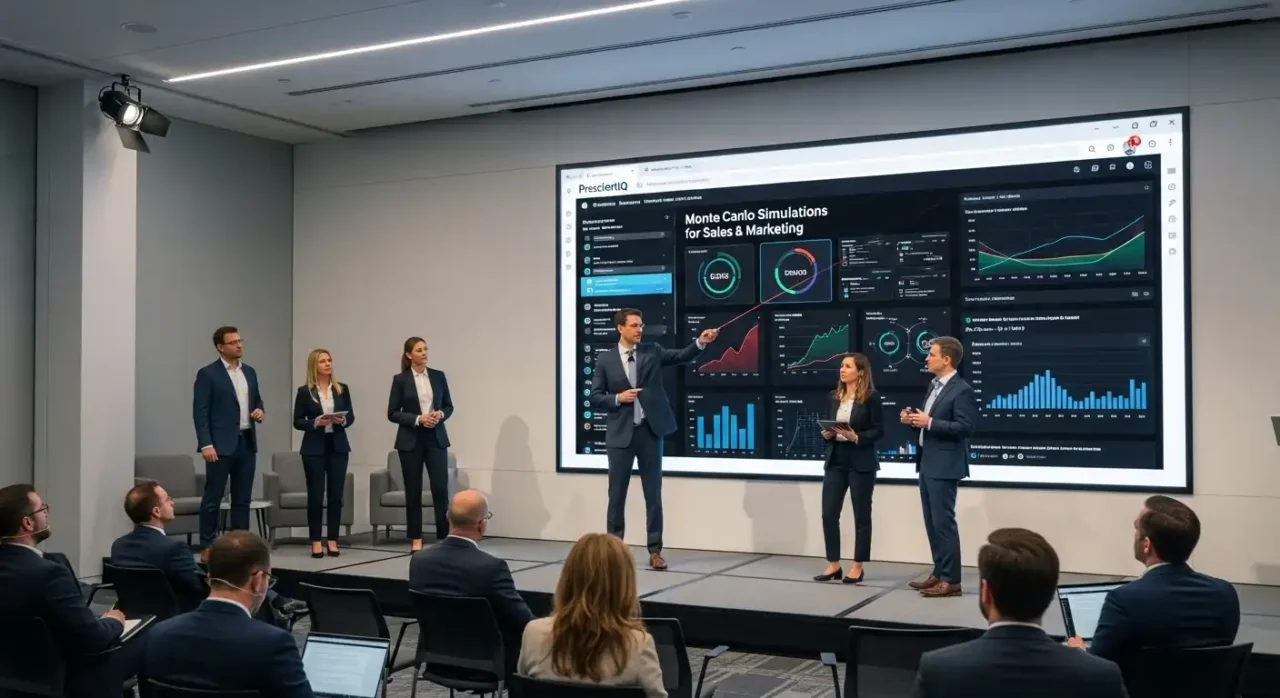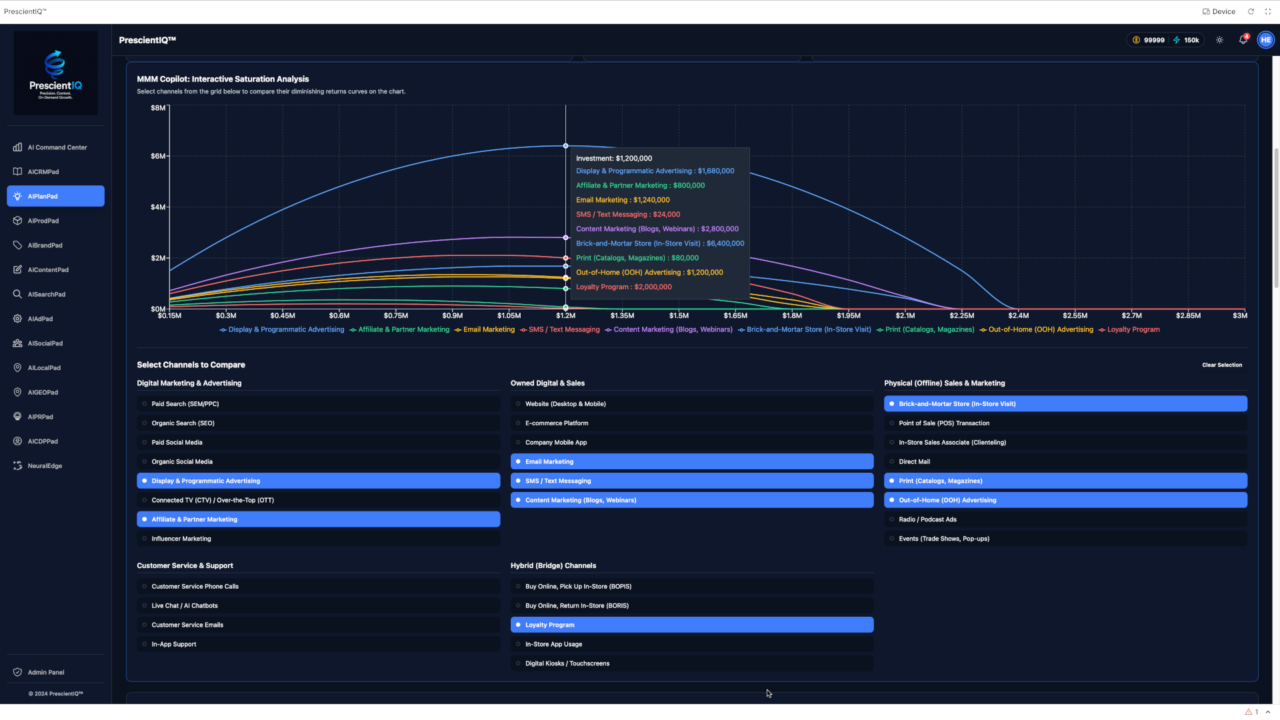Unified Causal Intelligence: The Next Evolution in Organizational Decision Science
Learn How Unified Causal Intelligence is The Next Evolution in Organizational Decision Science.
Introduction: From Data Overload to Causal Clarity
Organizations today are swimming in oceans of data — from marketing dashboards and CRM reports to finance systems and operational metrics.
Yet despite the explosion of analytics platforms, most enterprises remain stuck in a reactive, correlation-driven mindset.
They identify patterns (“sales dropped when ad spend fell”) but lack true causal understanding (“what exact combination of actions caused the sales decline — and what could reverse it?”).
This is the gap that Unified Causal Intelligence (UCI) closes.
From Promise to Performance
The Problem & The Pitch: Why We Need This Now. The harsh realities of implementation have overshadowed the promise of AI. Teams are drowning in tools and data, yet starving for action. MatrixLabX turns signals into decisions—and decisions into revenue.
What’s Broken
Predictive models say what might happen. Leaders need systems that recommend what to do next—with context, constraints, and confidence.
Business Headaches Galore
Too many tools. Too little traction.
The modern stack is a maze of point solutions. Data silos fracture the customer journey and balloon costs. Integration workstreams slow teams to a crawl.
Swimming in oil—without a refinery.
Dashboards. Reports. Spreadsheets. Insights die in slideware when no one can translate signal into the next best action.
Always chasing, never shaping.
Trend-chasing and competitor copycats create diminishing returns. Optimization of yesterday’s playbook misses tomorrow’s demand.
Human bandwidth hits the ceiling.
Manual processes cap reach and speed. Growth stalls when campaigns can’t scale with precision and consistency.
The Predictive AI Trap → The Prescriptive Advantage
Predictive AI (Black Box)
- Forecasts churn or campaign lift—but not what to do next
- Opaque features lead to stakeholder distrust
- Fails to generalize when markets shift
- Answers what without the why
Prescriptive AI (MatrixLabX)
- Recommends next best action with rationale
- Simulates trade‑offs across budget, channel, and timing
- Explains feature importance to build trust
- Closes the loop: action → observe → learn → scale
Why We Need This Now
Market Volatility
Disruption is the norm. Prescriptive systems adapt strategy in real time—no quarterly scramble.
Data is Abundant
You already have the signals. The edge comes from orchestrating action, not adding yet another feed.
Human Time is Scarce
Automate the routine to amplify the creative. Let teams focus on narrative, brand, and partnerships.
Stop Reporting. Start Prescribing.
Give your team a system that recommends, explains, and executes. From Frankenstack to flywheel—MatrixLabX helps marketing leaders compound growth.
What you’ll get
- Current‑state audit of tools, data, and workflows
- 90‑day prescriptive roadmap aligned to revenue goals
- Experiment backlog with expected impact & effort
Unified Causal Intelligence represents the next frontier in data-driven strategy — a synthesis of causal inference, predictive modeling, and quantum-enabled computation that allows organizations not only to see the past and present, but to simulate the future. It connects every business function — marketing, sales, finance, and operations — within a single, continuously learning causal ecosystem.
At the forefront of this revolution stands PrescientIQ, the platform purpose-built to operationalize Unified Causal Intelligence at enterprise scale.
PrescientIQ doesn’t just analyze your data — it gives your organization a causal brain. One that can de-risk decisions, understand true drivers of performance, automate growth strategies, and operate sustainably through quantum-native processing.
From Data Overload to Causal Clarity
Organizations today are swimming in oceans of data — from marketing dashboards and CRM reports to finance systems and operational metrics.
Yet despite the explosion of analytics platforms, most enterprises remain stuck in a reactive, correlation-driven mindset. They identify patterns (“sales dropped when ad spend fell”) but lack true causal understanding (“what exact combination of actions caused the sales decline — and what could reverse it?”).
This is the gap that Unified Causal Intelligence (UCI) closes.
Causal AI, Explained — From Correlation to Decisions
A one-page visual guide to what Causal AI is, how it differs from predictive AI, where it creates marketing impact, and how PrescientIQ operationalizes causal insights across industries.
Answers: “What will happen?”
- Finds correlations in historical data
- Great for propensity, forecasting, classification
- Optimizes within current conditions
- Examples: churn score, look-alike audience
Answers: “Why did it happen?” + “What if…?”
- Models cause-and-effect using causal graphs
- Estimates impact of interventions (do-calculus, counterfactuals)
- Guides strategy & budget reallocation
- Examples: channel lift, promo elasticity, journey drivers
Map the System
Define a causal graph: campaigns → behaviors → outcomes. Include confounders (seasonality, pricing, macro).
Estimate Effects
Use causal inference to isolate each lever’s true lift vs. noise and correlation.
Simulate “What-Ifs”
Run counterfactuals: “What if we increased creators +10% and reduced email cadence?”
Decide & Monitor
Deploy the chosen plan, then learn continuously as new data updates the model.
See the real drivers
Move past last-click. Quantify channel interactions and incremental lift across journeys.
Fund what causes growth
Shift dollars toward the highest causal ROI—by audience, message, and timing.
Model elasticity
Understand promo depth vs. margin trade-offs and long-term LTV impact.
Fix root causes
Identify onboarding, value gaps, or comms frequency that truly drive churn.
Prove brand’s impact
Link awareness & consideration to mid-/down-funnel outcomes over time.
Test less, learn more
Use simulations to narrow A/B scope and accelerate time-to-insight.
Product-led growth, quantified
- Link feature adoption → conversion → renewal
- Reveal enablement + success touchpoints that cause ARR lift
Dealer & channel clarity
- Isolate education vs. discount effects on orders
- Quantify event ROI vs. digital demand gen
Reputation into pipeline
- Prove thought leadership → inbound RFPs
- Prioritize events & partnerships that speed deals
Trust that converts
- Education content vs. ads for product uptake
- Macro signals → conversion risk by segment
Engagement with integrity
- Reminders & education that raise adherence
- Channel choices that earn patient trust
Playbooks that transfer
- Always-on learning updates the causal graph
- Shared language for Marketing × Finance
From Data Exhaust to Decision Intelligence
Connect
Unify CRM, ad, web/product, ERP & research data into a single causal canvas.
Discover
Auto-detect causal pathways and confounders; quantify true channel lift.
Simulate
Run portfolio scenarios (e.g., +10% creators, −15% paid search) before spending.
Orchestrate
Push decisions to execution tools; monitor real-world outcomes vs. counterfactuals.
- Transparent Trace recommendations to causal chains (no black box).
- Adaptive Models update as markets shift and new data streams in.
- Collaborative Shared metrics for Marketing × Finance × Product.
Your First 30 Days with Causal AI
Define business questions you can act on (e.g., “Which channels cause qualified pipeline?”).
Map your graph: touchpoints, outcomes, confounders (seasonality, pricing, macro).
Unify data from CRM, ads, web/product analytics; ensure time alignment.
Run simulations to rank budget reallocation opportunities by incremental ROI.
1. The Problem with Correlation-Driven Analytics
1.1 The Illusion of Insight
For two decades, business intelligence has been dominated by correlation-based analytics. Dashboards and AI tools detect relationships — if X goes up, Y tends to go down — but they stop short of telling us why.
This has led to what data scientists call the illusion of insight: organizations believe they understand what drives outcomes, when in reality, they are observing coincidences shaped by unmeasured confounders.
Marketing teams attribute revenue to campaigns that may not have caused the lift. Financial analysts overfit forecasts to historical noise.
Operations leaders optimize processes based on lagging indicators. Across departments, the same fundamental weakness persists — the inability to distinguish correlation from causation.
1.2 The Cost of Guesswork
This blind spot translates into enormous economic inefficiency.
Gartner estimates that over 60% of enterprise analytics investments fail to deliver measurable business impact because decisions are based on reactive or spurious correlations.
- Marketing overspends on channels that appear successful only due to attribution bias.
- Sales misses opportunities by relying on lagging CRM signals.
- Finance models budgets on historical averages that ignore causal dynamics.
- Operations optimize local efficiency at the expense of global performance.
Without causal clarity, organizations cannot simulate future outcomes or pre-emptively shape them. They are trapped in an endless loop of looking backward to move forward.
2. The Rise of Unified Causal Intelligence

2.1 Defining UCI
Unified Causal Intelligence is a computational and organizational framework for discovering, modeling, and acting upon causal relationships across every business domain.
It integrates causal inference, counterfactual simulation, and adaptive learning into a single, unified intelligence core.
In simple terms, UCI enables an organization to ask — and answer — the kinds of questions correlation-based analytics never could:
- What actually caused last quarter’s sales surge?
- If we cut marketing spend by 15%, what would the causal impact be on revenue and retention?
- Which operational levers most influence customer satisfaction and margin simultaneously?
- What if we launch a new product line in Q2 — how would it causally affect the rest of the business ecosystem?
UCI unites data, models, and decision processes around these questions to produce foresight that is both quantitative and causally valid.
2.2 Why “Unified” Matters
Historically, causal analysis has been confined to specialized silos — econometric models in finance, A/B testing in marketing, and optimization in supply chain management. But these fragmented insights rarely connect across functions.
The “Unified” in Unified Causal Intelligence represents the integration of all these causal signals into a single cognitive system that mirrors how an organization truly operates.
By unifying data and models across departments, UCI reveals cross-functional causality — how a pricing change influences marketing ROI, or how customer support response time affects sales pipeline velocity. This interconnectedness is where the greatest value lies.
3. The PrescientIQ Approach: Operationalizing UCI
PrescientIQ delivers Unified Causal Intelligence as a practical, enterprise-grade platform.
It doesn’t just theorize causality; it embeds it into the everyday decision-making fabric of the organization.
3.1 The Predictive Intelligence Core
At the heart of PrescientIQ is its predictive intelligence core — a unified computational substrate that replaces siloed analytics systems.
Rather than having separate models for marketing, finance, and operations, PrescientIQ integrates them into one continuously updating causal engine.
This unified “flight simulator” for business allows leaders to test strategies, adjust parameters, and visualize the ripple effects of decisions before they occur.
3.2 From Correlation to Causation: Quantum-Native Attribution
PrescientIQ introduces quantum-native attribution, an evolution beyond probabilistic correlation.
Using principles of quantum computing, the platform identifies entangled causal factors — the hidden interdependencies that traditional machine learning models cannot detect.
For example:
- Instead of just knowing that email campaigns correlate with higher revenue, PrescientIQ can isolate the causal impact of the timing, content, and customer micro-segment simultaneously.
- It models the probability distribution of outcomes before they happen, allowing for pre-factual simulation — seeing the future not as prediction, but as a range of causal possibilities.
This approach de-risks decisions by replacing intuition and backward-looking analytics with forward-tested strategies.
4. De-Risking Decisions with Pre-Factual Simulation

One of PrescientIQ’s most revolutionary capabilities is pre-factual simulation — the ability to model “what will happen if” scenarios before making a decision.
4.1 The Traditional “Post-Mortem” Problem
In most organizations, analysis happens after the fact. Budgets are spent, campaigns run, products launched — and only afterward do teams evaluate results.
This post-factual approach makes learning expensive, time-consuming, and often inconclusive.
4.2 The PrescientIQ Difference
With PrescientIQ, organizations run pre-factual simulations: digital experiments in a causal model of the business before committing resources.
This allows executives to:
- Test the causal impact of different marketing mixes before launch.
- Simulate financial outcomes under various pricing or macroeconomic conditions.
- Forecast operational bottlenecks before scaling production.
- Model sustainability trade-offs before changing supply chain configurations.
In effect, every decision becomes a flight simulation — allowing leaders to crash-test strategies safely in a virtual environment before applying them in the real world.
5. Understanding True Drivers of Behavior

5.1 Moving Beyond Correlational Attribution
Traditional marketing analytics tools report which channels “drive” conversions, but their attributions are often statistical mirages.
They cannot separate true causal influence from mere coincidence.
PrescientIQ’s quantum-native attribution engine identifies the actual causes behind customer actions, financial shifts, or operational outcomes. It understands why a behavior occurred, not just that it did.
5.2 The Causal Graph in Action
Using advanced causal graphs, PrescientIQ models complex systems as networks of influence.
Each node represents a variable (ad spend, brand sentiment, pricing, competitor activity), and each edge represents a directional causal relationship quantified by strength and probability.
This allows analysts to see not only which levers move the outcome, but also how they interact with each other. For instance, PrescientIQ might reveal that:
- 40% of new customer growth is causally driven by cross-channel synergy between paid search and referral programs.
- A 5% price increase could causally reduce churn by improving perceived quality — but only in segments with high brand trust.
- Reducing customer service response time by 10% causally increases upsell conversion by 12%.
This level of insight transforms marketing and operations from reactive management to causal engineering.
6. Automating Growth with Adaptive AI Agents
6.1 From Predictive Analytics to Autonomous Optimization
Most AI systems today generate insights for humans to act upon. PrescientIQ goes a step further — it enables adaptive AI agents that act autonomously on causal intelligence. These agents continuously learn from live probabilistic forecasts and refine strategies in real time.
For example:
- A marketing agent can dynamically reallocate ad spend across channels as causal efficiency changes.
- A sales agent can adjust pricing or promotions based on predicted causal impact on margin.
- A finance agent can rebalance capital allocation in response to shifting macro-causal drivers.
6.2 The Self-Optimizing Enterprise
By deploying these agents, organizations move toward a self-optimizing state — where causal understanding fuels autonomous, coordinated adaptation across functions.
PrescientIQ’s agents collaborate through shared causal models, ensuring that every micro-decision aligns with enterprise-wide goals.
This is not “automation for automation’s sake.” It’s intelligent automation rooted in causality — where every action is explainable, auditable, and continuously improved.
7. Operating Efficiently with Green AI and Quantum Processing
7.1 The Sustainability Problem in AI
Conventional AI systems are computationally hungry, consuming vast amounts of energy for model training and inference.
This creates a growing tension between digital innovation and environmental sustainability.
7.2 Quantum-Native Efficiency
PrescientIQ solves this through its green AI ecosystem, built on quantum processing principles. Quantum computation enables PrescientIQ to model multivariate causal relationships with far fewer resources than classical architectures.
It doesn’t brute-force through massive data combinations — it explores superpositions of causal states simultaneously, dramatically reducing computational waste.
The result is a platform that is not only smarter but also more sustainable, helping organizations achieve both performance and ESG goals simultaneously.
8. The Four Pillars of PrescientIQ’s Unified Causal Intelligence
To understand how PrescientIQ translates theory into execution, it’s helpful to frame its architecture around four foundational pillars:
| Pillar | Description | Outcome |
| 1. Integration | Merges marketing, sales, finance, and operations data into a unified causal graph. | Eliminates silos and surfaces cross-functional causal drivers. |
| 2. Simulation | Runs pre-factual “what-if” scenarios to test future decisions. | De-risks strategy and improves ROI predictability. |
| 3. Adaptation | Deploys AI agents that autonomously learn from live data. | Automates growth and operational optimization. |
| 4. Sustainability | Leverages quantum processing for efficiency and lower energy use. | Reduces computational costs and supports green initiatives. |
Each pillar feeds the next in a virtuous cycle — integration enables simulation; simulation informs adaptation; adaptation drives sustainable, intelligent growth.
9. Use Cases: Unified Causal Intelligence in Action
9.1 Marketing Optimization
A global e-commerce company uses PrescientIQ to identify the causal chain linking ad spend to lifetime customer value.
The system discovers that retention campaigns causally drive 2.4× more long-term revenue than first-touch acquisition ads — a fact masked in correlational data.
Pre-factual simulations then guide an optimal reallocation of spend, improving ROI by 35%.
9.2 Financial Forecasting
A fintech firm deploys PrescientIQ to understand causal links between macroeconomic variables, customer credit behavior, and profitability.
Its simulations reveal that a 0.5% change in interest rates causally alters risk exposure by 8% in certain portfolios.
The finance team uses this insight to pre-emptively adjust hedging strategies, saving millions in potential losses.
9.3 Operations and Supply Chain
A manufacturer integrates operations data into PrescientIQ’s causal model.
The system identifies that equipment downtime and logistics delays share a latent causal driver — vendor scheduling mismatches — rather than independent failures.
By addressing this root cause, operational efficiency improves by 18%, and carbon emissions drop by 12%.
9.4 Strategic Planning
At the C-suite level, PrescientIQ serves as a decision cockpit.
Executives use the platform to simulate the causal impact of mergers, product launches, or restructuring.
This transforms boardroom strategy from educated guesswork into causally tested foresight.
10. The Science Behind Unified Causal Intelligence

10.1 Causal Inference and Structural Equation Modeling
At its foundation, UCI relies on causal inference theory — the statistical framework that distinguishes cause from correlation.
It uses structural equation models (SEMs) and directed acyclic graphs (DAGs) to represent causal structures among variables.
By applying interventions (the “do” operator), the system estimates what would happen if one variable were actively changed — the cornerstone of causal reasoning.
10.2 Counterfactual and Pre-Factual Modeling
UCI extends causal inference into counterfactual reasoning (“what would have happened if we did X instead of Y”) and pre-factual simulation (“what will happen if we do X in the future”).
PrescientIQ’s quantum-native architecture enables it to simulate multiple futures in parallel, generating probabilistic forecasts that naturally incorporate uncertainty.
10.3 Quantum-Native Computation
Traditional machine learning searches through data sequentially; quantum computation evaluates causal relationships simultaneously across multiple potential states.
This parallelism enables PrescientIQ to handle complex causal systems — with thousands of interdependent variables — at enterprise scale and speed.
11. Cultural Transformation: From Reactive to Prescient Organizations
11.1 The Mindset Shift
Adopting Unified Causal Intelligence is not just a technological upgrade; it’s a cultural evolution. It shifts the organizational mindset from reacting to reports to designing futures.
Instead of asking, “What happened?” teams begin asking, “What will happen if we act this way — and how can we shape it?”
11.2 Decision Intelligence as a Core Competency
PrescientIQ enables Decision Intelligence — the integration of data science, psychology, and management to improve decision-making.
By embedding UCI into daily workflows, organizations democratize causal insight.
Every team member, from analyst to executive, gains access to a living model of how the business truly works.
11.3 Cross-Functional Collaboration
Because PrescientIQ unifies causal data across departments, it fosters collaboration.
Marketing understands how financial constraints influence campaign timing; operations anticipates the causal effect of customer demand surges; finance models how operational efficiencies cascade into cash flow improvements.
The result is a causally aligned enterprise, where every decision harmonizes with the broader organizational system.
12. Measuring the Impact of UCI
12.1 Quantitative Gains
Organizations adopting PrescientIQ typically observe measurable improvements across key metrics:
- 30–50% reduction in decision cycle time.
- 20–40% increase in marketing ROI due to causal optimization.
- 15–25% improvement in forecasting accuracy.
- Up to 60% reduction in redundant computational cost from green AI optimization.
12.2 Qualitative Benefits
Beyond numbers, the adoption of UCI produces qualitative transformations:
- Confidence in decision-making, backed by causal evidence.
- Agility, as simulations replace lengthy post-hoc analysis cycles.
- Accountability, as every strategic move has a causally traceable rationale.
- Innovation, as teams can safely explore hypothetical futures in virtual environments.
13. The Road Ahead: Toward Quantum-Causal Enterprises
13.1 Merging Human and Machine Intelligence
The ultimate goal of Unified Causal Intelligence is to create a symbiotic relationship between human intuition and machine reasoning.
PrescientIQ’s explainable models allow humans to understand and validate AI-derived causality, fostering trust and collaboration.
13.2 Continuous Causal Learning
PrescientIQ’s system continuously refines its models as new data arrives, creating an ever-evolving causal graph of the organization.
This means that causal understanding never becomes obsolete — it grows alongside the business.
13.3 The Quantum Horizon
As quantum computing matures, PrescientIQ is poised to scale its causal simulations from enterprise-level to global systemic intelligence — modeling entire ecosystems of businesses, markets, and environments to predict and shape macro-economic futures.
14. Why PrescientIQ Is the Vanguard of the UCI Era

In a world saturated with dashboards and machine learning models, PrescientIQ stands apart by redefining the core question from “What does the data say?” to “What will happen if we act this way — and why?”
Through its delivery of Unified Causal Intelligence, PrescientIQ transforms decision-making into a scientific discipline grounded in causal truth, operational efficiency, and sustainable intelligence.
PrescientIQ delivers Unified Causal Intelligence, moving your entire organization from reacting to correlations to proactively simulating and shaping future outcomes as we move into quantum computing applications in sales and marketing.
It achieves this through a single predictive intelligence core that:
- De-Risks Decisions with pre-factual simulations.
- Understands Causality via quantum-native attribution.
- Automates Growth through adaptive AI agents.
- Operates efficiently within a sustainable, green-AI ecosystem.
In short, PrescientIQ gives organizations the power not just to predict the future, but to design it presciently.
Conclusion: From Guesswork to Causal Mastery
The era of correlation-based business intelligence is ending. The next generation of leaders will not merely analyze data — they will engineer outcomes.
Unified Causal Intelligence marks this transition: a move from hindsight to foresight, from dashboards to simulations, from reactivity to prescience.
And PrescientIQ is the platform turning that vision into operational reality.
By embedding causal reasoning, quantum computation, and adaptive AI into the organizational nervous system, PrescientIQ enables businesses to evolve from data-rich but decision-poor to causally intelligent and future-ready.
In doing so, it fulfills the ultimate goal of intelligence.
Matrix Marketing Group Launches Performance-Based Pricing for Mid-Market Companies
Powered by our proprietary MatrixLabX AI, we're eliminating traditional retainers to link our compensation directly to your results—reducing risk and maximizing your ROI.
A Fundamental Shift in Accountability
We're moving away from outdated models that reward effort to a modern approach that guarantees results.
The Old Way: Traditional Agencies
- ✖Pay for effort, not outcomes
- ✖High financial risk on your budget
- ✖Opaque ROI and unclear value
- ✖Misaligned incentives and goals
The Matrix Way: Performance Partnership
- ✔Pay only for measurable results
- ✔Minimized risk, maximized budget efficiency
- ✔Crystal-clear, transparent ROI
- ✔A true partnership with aligned success
Flexible, Performance-Based Pricing
Choose the model that best fits your business goals. Each one is designed to ensure our success is directly tied to yours.
Pay Only for Qualified Leads
This model is ideal for businesses focused on filling their sales funnel with high-intent prospects. You only pay when we deliver a lead that meets your specific criteria, validated by our AI for quality, ICP fit, and engagement level. It's a straightforward way to guarantee your marketing spend translates directly into sales opportunities.
The Intelligence Behind the Results: MatrixLabX
Our proprietary AI platform is the engine that powers our performance models, moving beyond simple automation to deliver intelligent, self-improving campaigns.
Data Ingestion & Analysis
MatrixLabX analyzes real-time signals from your marketing channels, CRM, and the wider market to build a deep understanding of your audience.
AI-Powered Optimization
The AI core uses predictive analytics for lead scoring, campaign optimization, and dynamic adjustments to ensure maximum efficiency.
Measurable Outcomes
The result is a stream of qualified leads, higher conversion rates, and a clear, transparent ROI that you can track in real-time.
The Proof is in the Performance
We're not just following a trend; we're leveraging a proven model we helped pioneer, backed by industry data and decades of experience.
0
Higher ROI
Reported by clients using our performance pricing models vs. traditional retainers.
0
Industry Shift
Of top agencies expected to abandon hourly rates for value-based pricing by 2025.
0
Pioneering Since
When we launched the industry's first successful paid performance public relations program.
Client Success: Performance vs. Traditional Models
Ready to Align Your Marketing with Your Growth?
Our performance-based model is designed for mid-market companies with revenues between $5 million and $100 million. If that's you, let's talk.

